Effects of Ground Floor Type on Selected Health-Parameters and Weight of Rabbits Reared in Group Pens
Simple Summary
Abstract
1. Introduction
2. Animals, Materials and Methods
2.1. Animals and Housing
2.2. Allocation of Animals to Treatments
2.3. Recorded Parameters
2.3.1. Soiling of Pens and Animals and Hind Leg Condition
2.3.2. Parasitic Load
2.3.3. Mortality and Post-Mortem Examinations
2.3.4. Weight Data
2.3.5. Activity Analysis
2.4. Data Analysis
3. Results
3.1. Health-Related Parameters
3.1.1. Soiling and Wetness of Pens
3.1.2. Soiling of Animals and Hind Leg Condition
3.1.3. Parasitic Load
3.1.4. Mortality, Causes of Loss, and Overall Pathological Findings
3.2. Weight and Activity
4. Discussion
4.1. Effect of Ground Floor Type on Health-Related Parameters
4.1.1. Degree of Soiling
4.1.2. Parasitism
4.1.3. Mortality, Causes of Loss, and Overall Pathological Findings
4.2. Effect of Ground Floor Type on Weight and Activity
4.3. Trial Effects
5. Conclusions
Supplementary Materials
Author Contributions
Funding
Acknowledgments
Conflicts of Interest
References
- Trocino, A.; Xiccato, G. Animal welfare in reared rabbits: A review with emphasis on housing systems. World Rabbit Sci. 2006, 14, 77–93. [Google Scholar] [CrossRef]
- Trocino, A.; Filiou, E.; Tazzoli, M.; Birolo, M.; Zuffellato, A.; Xiccato, G. Effects of floor type, stocking density, slaughter age and gender on productive and qualitative traits of rabbits reared in collective pens. Animal 2015, 9, 855–861. [Google Scholar] [CrossRef] [PubMed]
- Stauffacher, M. Group housing and enrichment cages for breeding, fattening and laboratory rabbits. Anim. Welfare 1992, 1, 105–125. [Google Scholar]
- Gunn, D.; Morton, D.B. Inventory of the behaviour of New Zealand White rabbits in laboratory cages. Appl. Anim. Behav. Sci. 1995, 45, 277–292. [Google Scholar] [CrossRef]
- European Food Safety Authority (EFSA). Scientific Report “The impact of the current housing and husbandry systems on the health and welfare of farmed domestic rabbit”. EFSA-Q-2004-023. EFSA J. 2005, 267, 1–31. [Google Scholar]
- Bayvel, A.C.D.; Diesch, T.J.; Cross, N. Animal welfare: A complex international public policy issue: Economic, policy, societal, cultural and other drivers and constraints. A 20-year international perspective. Anim. Welfare 2012, 21, 11–18. [Google Scholar] [CrossRef]
- Sommerville, R.; Ruiz, R.; Averós, X. A meta-analysis on the effects of the housing environment on the behaviour, mortality, and performance of growing rabbits. Anim. Welfare 2017, 26, 223–238. [Google Scholar] [CrossRef]
- Gerencsér, Z.; Szendrő, K.; Szendrő, Z.; Odermatt, M.; Radnai, I.; Nagy, I.; Dal Bosco, A.; Matics, Z. Effect of floor type on behavior and productive performance of growing rabbits. Livestock Sci 2014, 165, 114–119. [Google Scholar] [CrossRef]
- Tuyttens, F.A.M. The importance of straw for pig and cattle welfare: A review. Appl. Anim. Behav. Sci. 2005, 92, 261–282. [Google Scholar] [CrossRef]
- Morisse, J.P.; Boilletot, E.; Martrenchar, A. Preference testing in intensively kept meat production rabbits for straw on wire grid floor. Appl. Anim. Behav. Sci. 1999, 64, 71–80. [Google Scholar] [CrossRef]
- Orova, Z.; Szendrő, Z.; Matics, Z.; Radnai, I.; Biró-Németh, E. Free choice of growing rabbits between deep litter and wire net floor in pens. In Proceedings of the 8th World Rabbit Congress, Puebla City, Mexico, 7–10 September 2004; pp. 1263–1265. [Google Scholar]
- Bessei, W.; Tinz, J.; Reiter, K. Die Präferenz von Mastkaninchen für Kunststoffgitter und Tiefstreu bei unterschiedlichen Temperaturen. In Proceedings of the 12th Arbeitstagung über Haltung und Krankheiten der Kaninchen, Pelztiere und Heimtiere, Celle, Germany, 9–10 May 2001; pp. 133–140. [Google Scholar]
- Ruis, M. Group housing of breeding does. In Recent Advances in Rabbit Sciences, 1st ed.; Maertens, L., Coudert, P., Eds.; Institute for Agricultural and Fisheries Research (ILVO): Merelbeke, Belgium, 2006; pp. 99–105. [Google Scholar]
- Licois, D. Domestic rabbit entropathies. In Proceedings of the 8th World Rabbit Congress, Puebla City, Mexico, 7–10 September 2004; pp. 385–403. [Google Scholar]
- Pakandl, M. Coccidia of rabbit: A review. Folia Parasitol. 2009, 56, 153–166. [Google Scholar] [CrossRef] [PubMed]
- Lambertini, L.; Vignola, G.; Zaghini, G. Alternative pen housing system for fattening rabbits: Effect of group density and litter. World Rabbit Sci. 2001, 9, 141–147. [Google Scholar] [CrossRef]
- Dal Bosco, A.; Castellini, C.; Mugnai, C. Rearing rabbits on a wire net floor or straw litter: behaviour, growth and meat qualitative traits. Livest. Prod. Sci. 2002, 75, 149–156. [Google Scholar] [CrossRef]
- Szendrő, Z.; Dalle Zotte, A. Effect of housing conditions on production and behaviour of growing meat rabbits: A review. Livest. Sci. 2011, 137, 296–303. [Google Scholar] [CrossRef]
- Trocino, A.; Xiccato, G.; Majolini, D.; Fragkiadakis, M. Effect of cage floor and stocking density on growth performance and welfare of group-housed rabbits. In Proceedings of the 9th World Rabbit Congress, Verona, Italy, 10–13 June 2008; pp. 1251–1255. [Google Scholar]
- Metzger, S.; Kustos, K.; Szendrő, Z.; Szabó, A.; Eiben, C.; Nagy, I. The effect of housing system on carcass traits and meat quality of rabbit. World Rabbit Sci 2003, 11, 1–11. [Google Scholar] [CrossRef]
- Princz, Z.; Dalle Zotte, A.; Metzger, S.; Radnai, I.; Biró-Németh, E.; Orova, Z.; Szendrő, Z. Response of fattening rabbits reared under different housing conditions. 1. Live performance and health status. Livest. Sci. 2009, 121, 86–91. [Google Scholar] [CrossRef]
- Tillmann, K.; Windschnurer, I.; Gamper, J.; Hinney, B.; Rülicke, T.; Podesser, B.K.; Troxler, J.; Plasenzotti, R. Welfare assessment in rabbits raised for meat and laboratory purposes in enclosures with two floor types: Perforated plastic with holes versus slats. Res. Vet. Sci. 2019, 122, 200–209. [Google Scholar] [CrossRef]
- Coenen, E.; Ruis, M. Dichte vloeren belangrijke oorzaak van bevuiling dieren. NOK Kontaktblad 2003, 21–26. [Google Scholar]
- McBride, A. Rabbits & Hares, 1st ed.; Whittet books Ltd.: Suffolk, UK, 2003. [Google Scholar]
- Masthoff, T.; Lang, C.; Hoy, S. Effect of group size on fattening performance and of various types of slatted floor on dirtiness and occurrence of pododermatitis in growing rabbits. In Proceedings of the 11th World Rabbit Congress, Qingdao, China, 15–18 June 2016; pp. 715–718. [Google Scholar]
- Bauer, C. Parasitosen des Kaninchens: Protozoeninfektionen des Kaninchens. In Veterinärmedizinsche Parasitologie, 6th ed.; Schnieder, T., Ed.; Parey: Berlin, Germany, 2000; pp. 561–566. [Google Scholar]
- Blas, F.; Gidenne, T. Digestion of Sugars and Starch. In Nutrition of the rabbit, 2nd ed.; de Blas, C., Wisemann, J., Eds.; CAB International: Wallingford, UK, 2010; p. 32. [Google Scholar]
- Gidenne, T.; García, J.; Lebas, F.; Licois, D. Nutrition & Feeding Strategy: Interactions with Pathology. In Nutrition of the Rabbit, 2nd ed.; de Blas, C., Wisemann, J., Eds.; CAB International: Wallingford, UK, 2010; pp. 179–180. [Google Scholar]
- Maertens, L.; Van Herck, A. Performances of weaned rabbits raised in pens or in classical cages: First results. In Proceedings of the 7th World Rabbit Congress, Valencia, Spain, 4–7 July 2000; pp. 435–440. [Google Scholar]
- European Parliament. Committee on Agriculture and Rural Development. Report on minimum standards for the protection of farm rabbits (2016/2077(INI)). 2017. Available online: http://www.europarl.europa.eu/sides/getDoc.do?pubRef=-//EP//NONSGML+REPORT+A8-2017-0011+0+DOC+PDF+V0//EN (accessed on 11 January 2019).
- Rashwan, A.A.; Marai, I.F.M. Mortality in young rabbits: a review. World Rabbit Sci. 2000, 8, 111–124. [Google Scholar]
- Coudert, P.; Rideaud, P.; Virag, G.; Cerrone, A. Pasteurellosis in rabbits. In Recent Advances in Rabbit Sciences, 1st ed.; Maertens, L., Coudert, P., Eds.; Institute for Agricultural and Fisheries Research (ILVO): Merelbeke, Belgium, 2006; pp. 147–162. [Google Scholar]
- Rosell, J.M.; de la Fuente, L.F. Causes of mortality in breeding rabbits. Prev. Vet. Med. 2016, 127, 56–63. [Google Scholar] [CrossRef]
- Jekkel, G.; Milisits, G.; Nagy, I.; Biró-Németh, E. Analysis of the behaviour of growing rabbits housed in deep litter at different stages of rearing. In Proceedings of the 9th World Rabbit Congress, Verona, Italy, 10–13 June 2008; pp. 1189–1193. [Google Scholar]
- Princz, Z.; Dalle Zotte, A.; Radnai, I.; Biró-Németh, E.; Matics, Z.; Gerencsér, Z.; Nagy, I.; Szendrő, Z. Behaviour of growing rabbits under various housing conditions. Appl. Anim. Behav. Sci. 2008, 111, 342–356. [Google Scholar] [CrossRef]
- Fels, M.; Rauterberg, S.; Kimm, S.; Bill, J.; Kemper, N. Mastkaninchen nach Tiercshutz-Nutztierhaltungsverordnung—Wohl oder Übel für die Tiere? In Proceedings of the 25th Internationale DVG-Fachtagung zum Thema Tierschutz und 17th internationale Fachtagung zum Thema Ethologie und Tierhaltung, Munich, Germany, 14–16 March 2019; pp. 197–210. [Google Scholar]
- Lang, C. Klinische und ethologische Untersuchungen zur Haltung wachsender Kaninchen. Ph.D. Thesis, Justus-Liebig-University, Gießen, Germany, 2009. [Google Scholar]
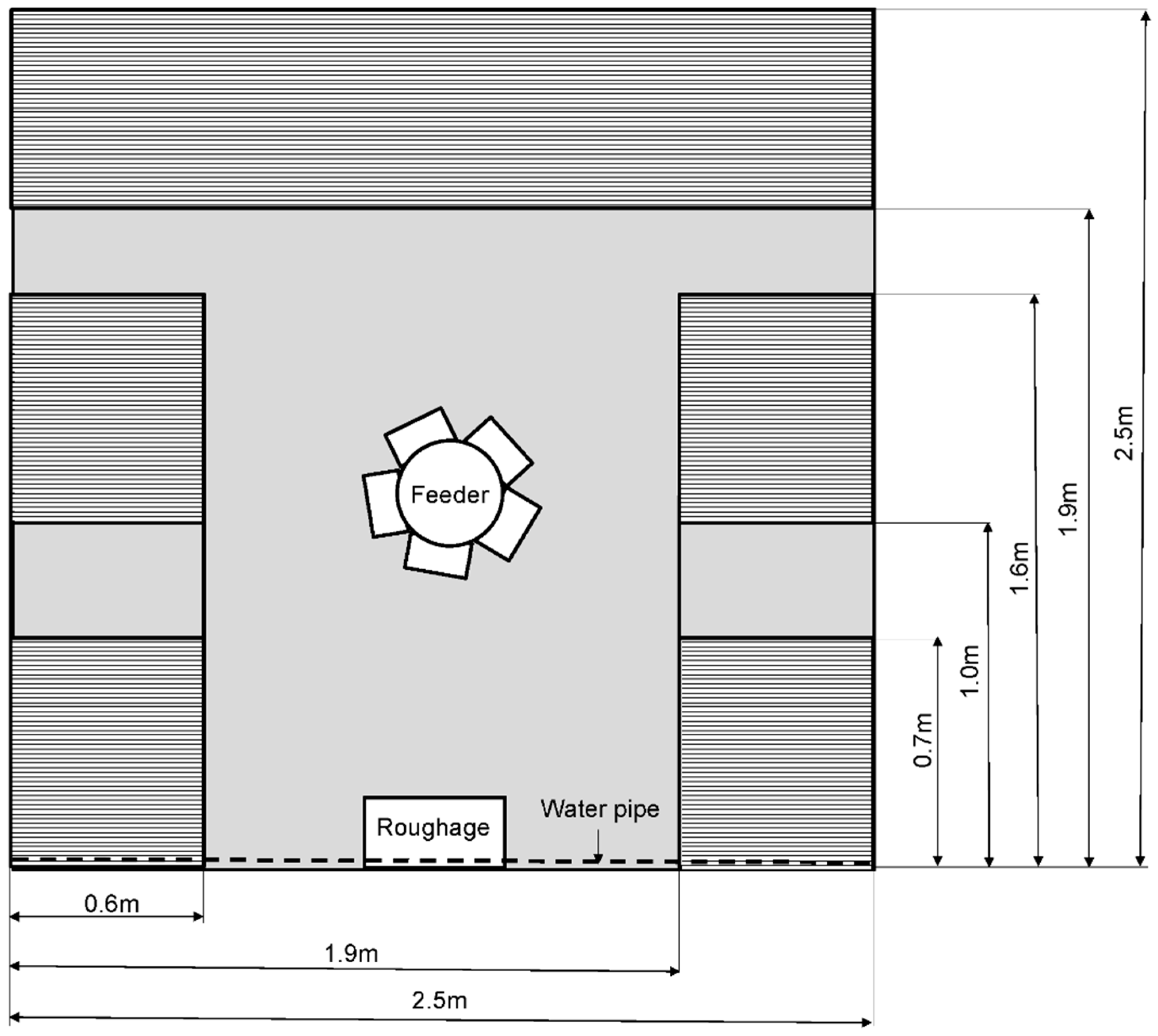
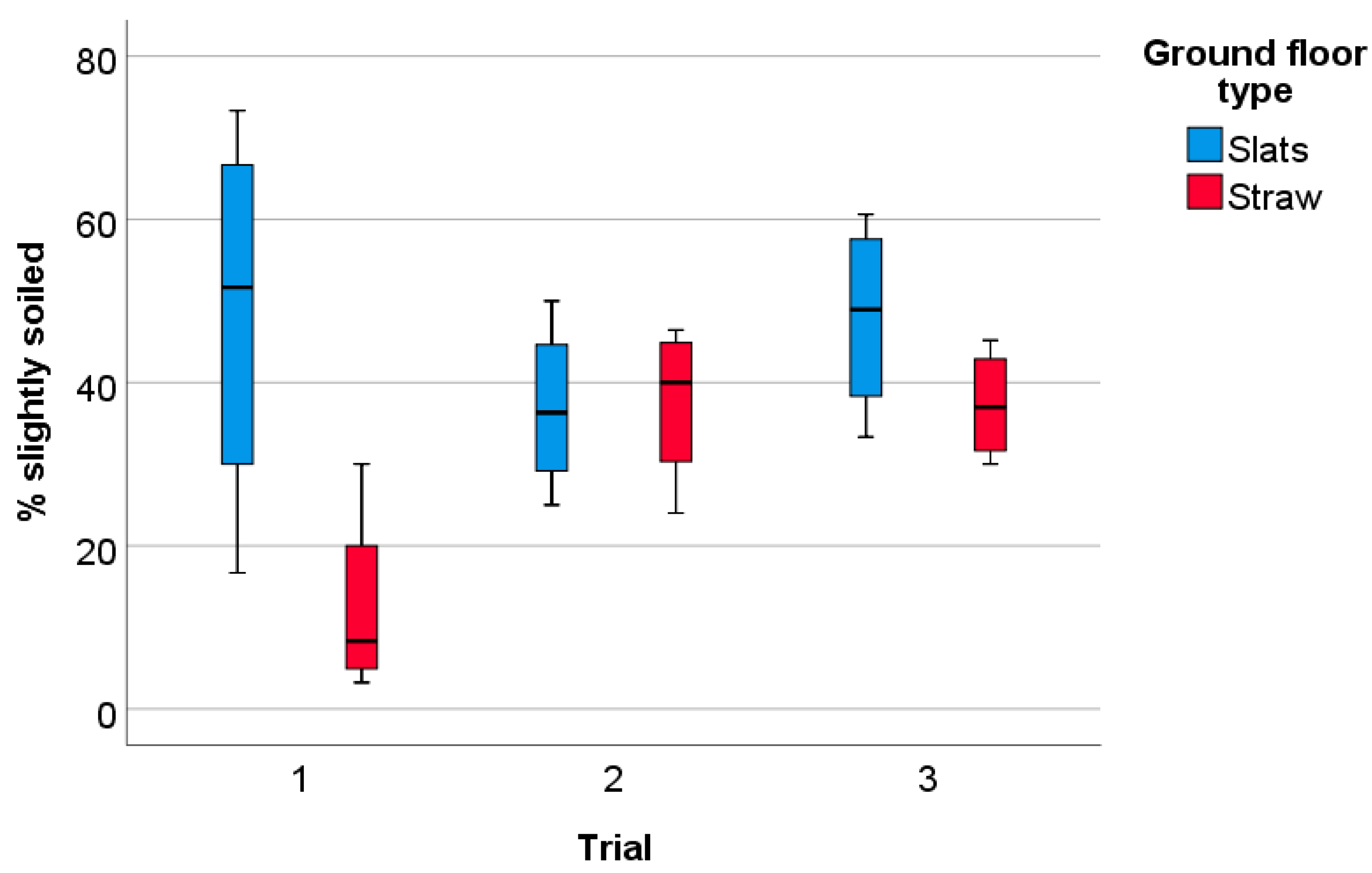
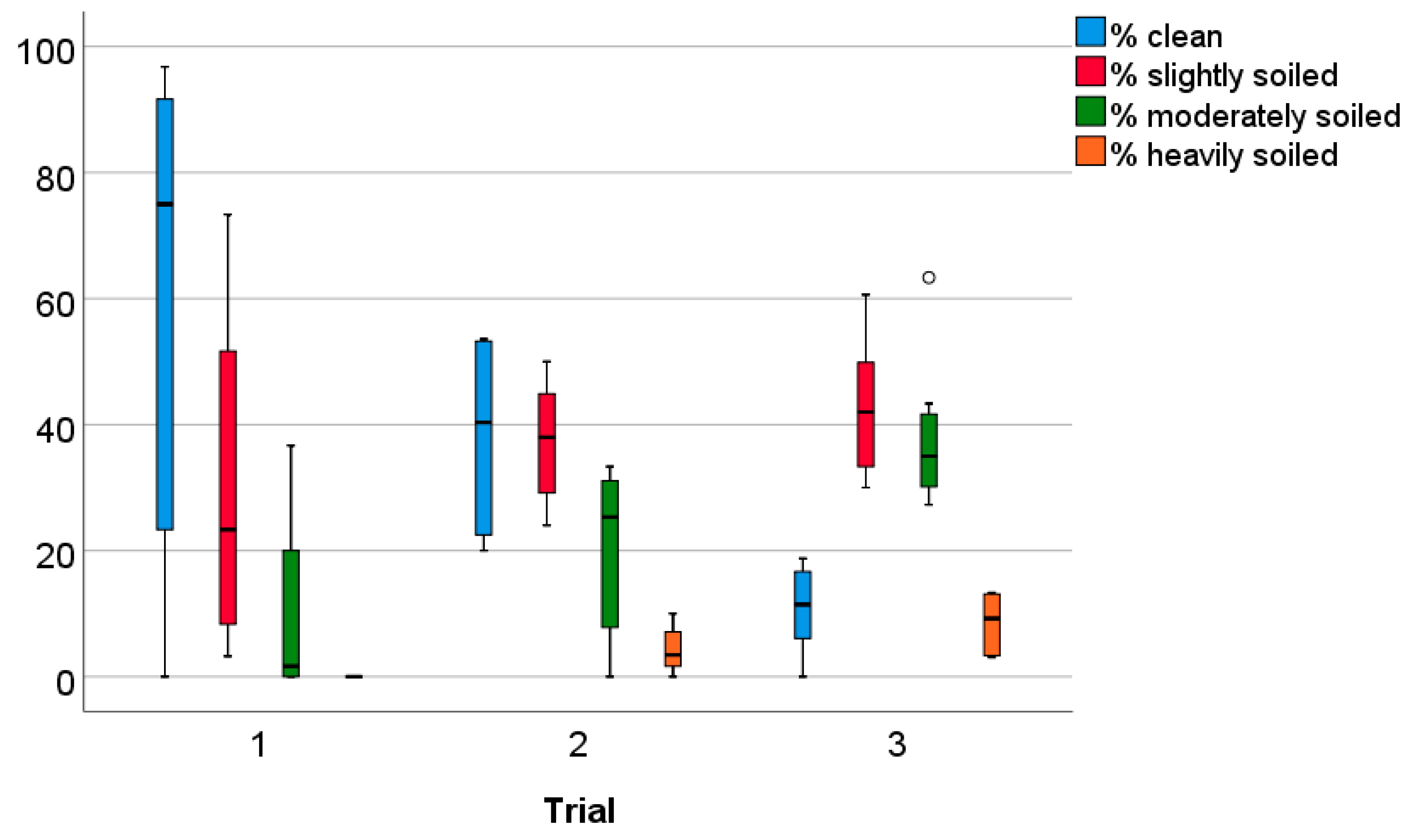
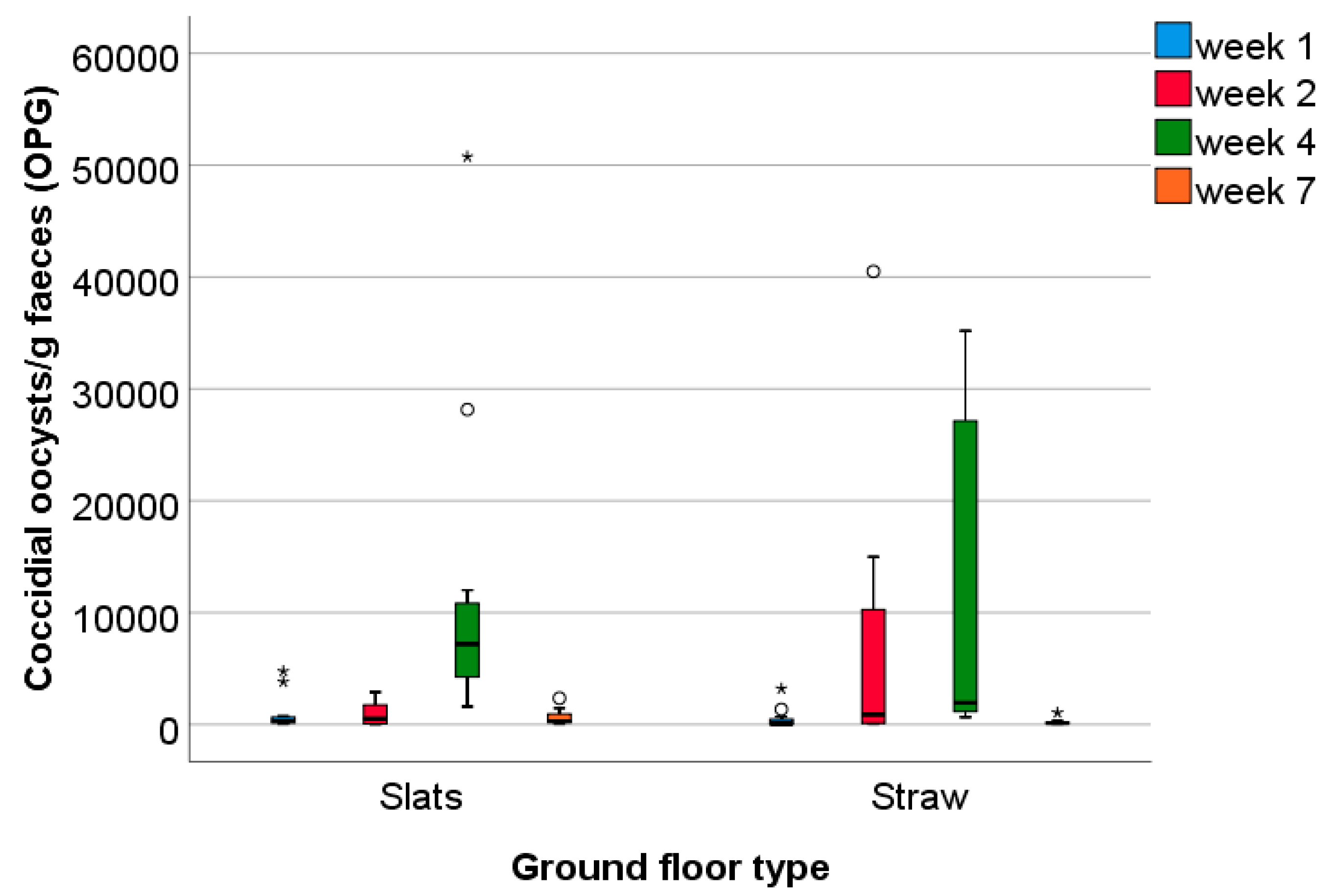
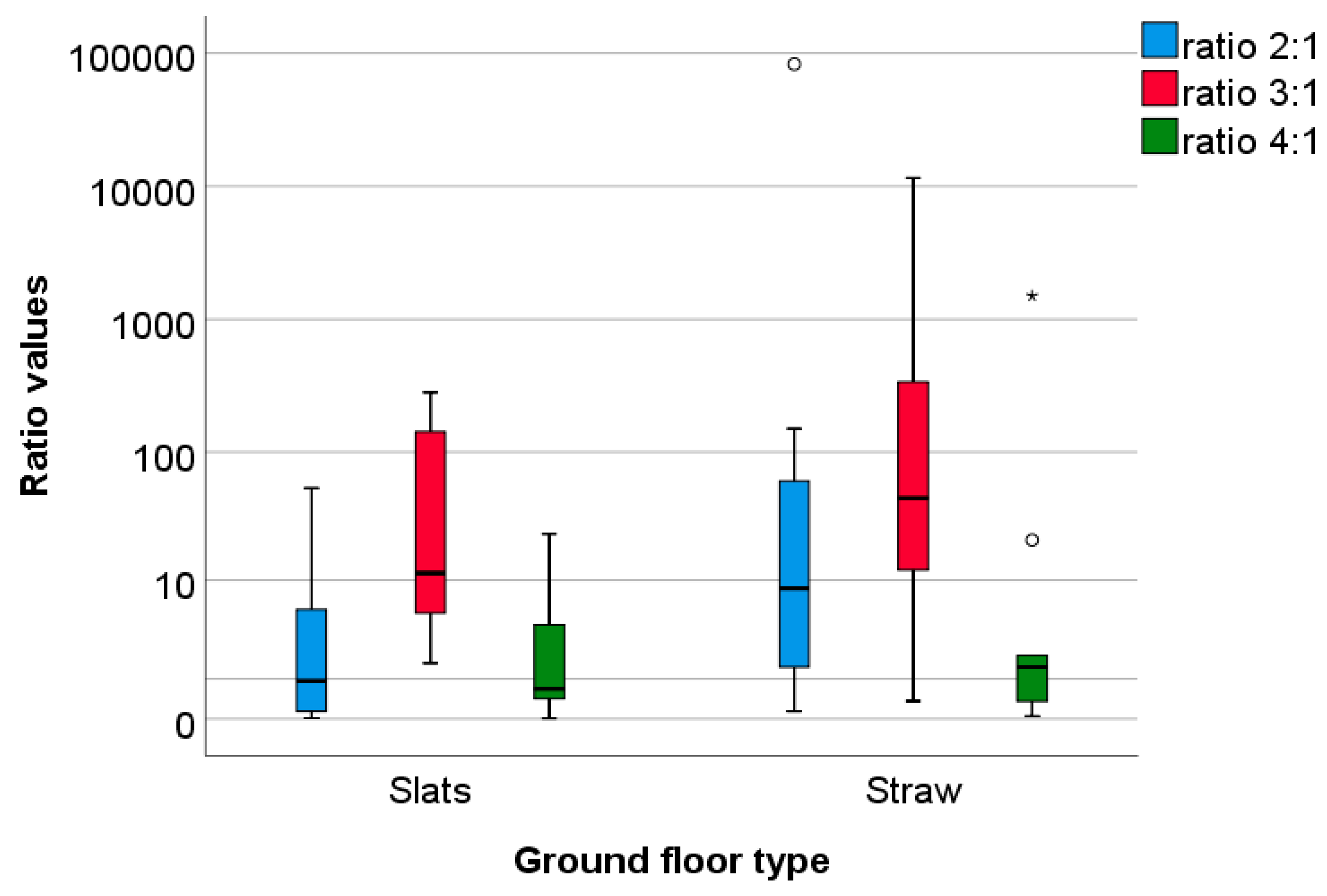
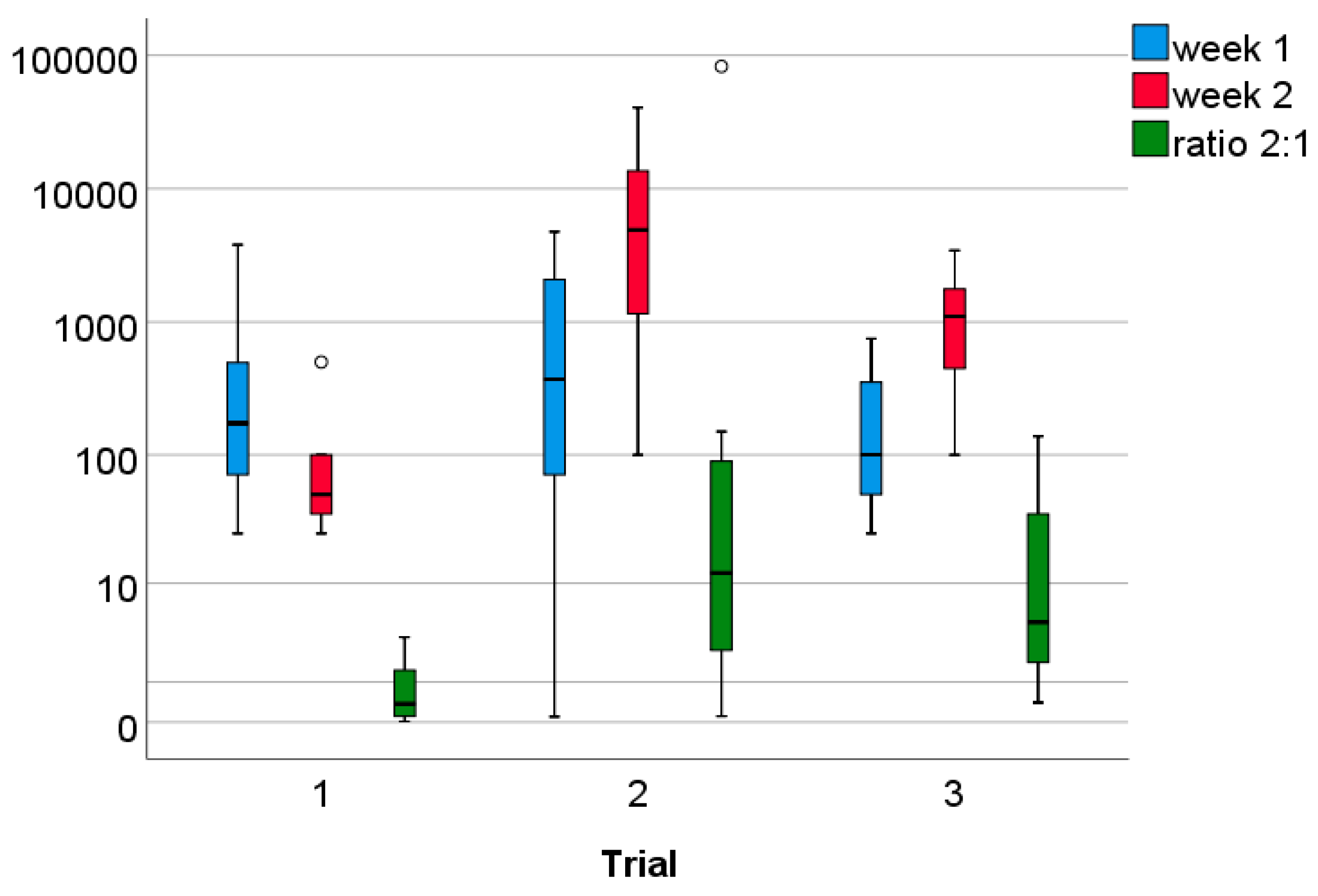
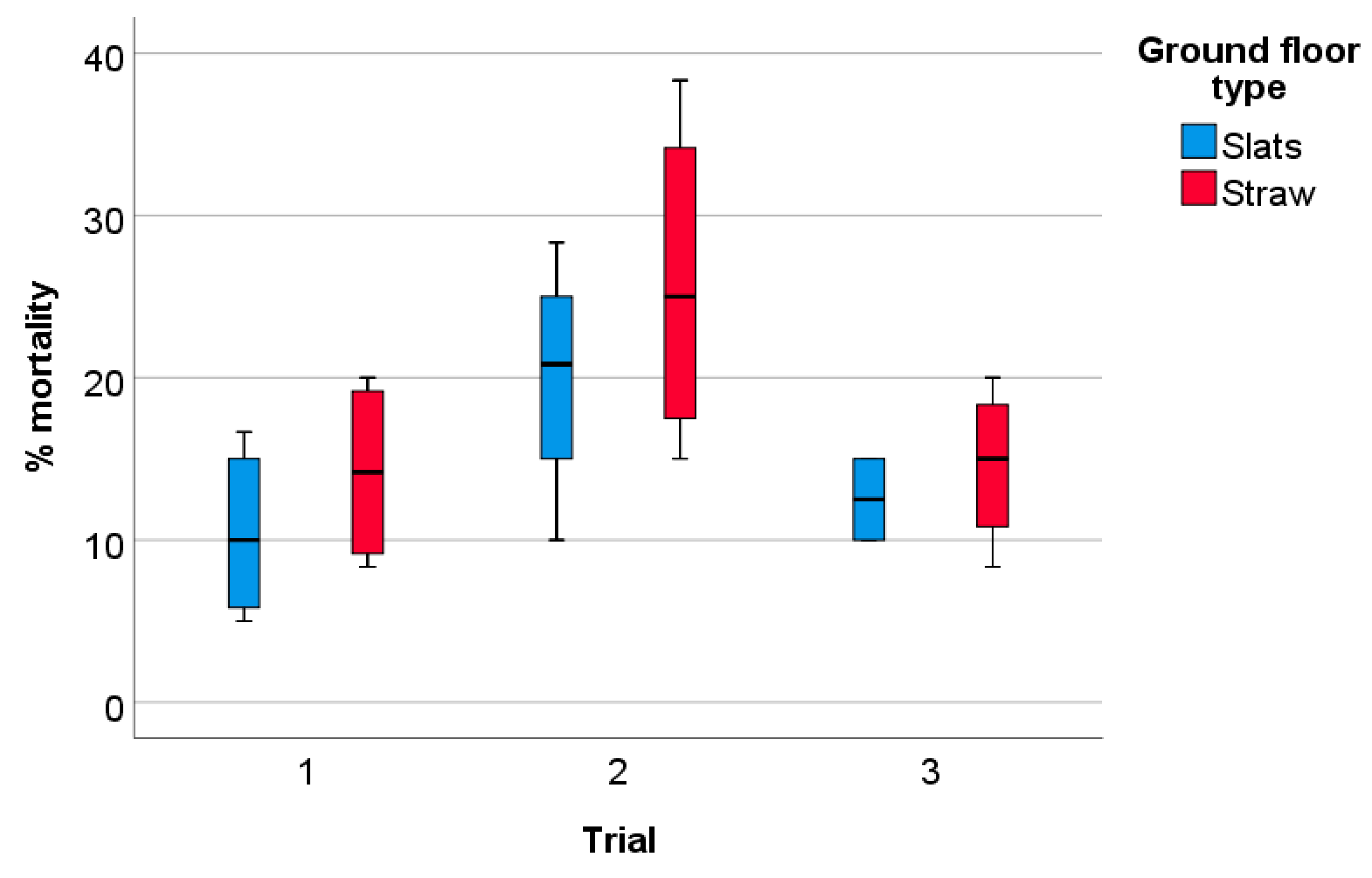
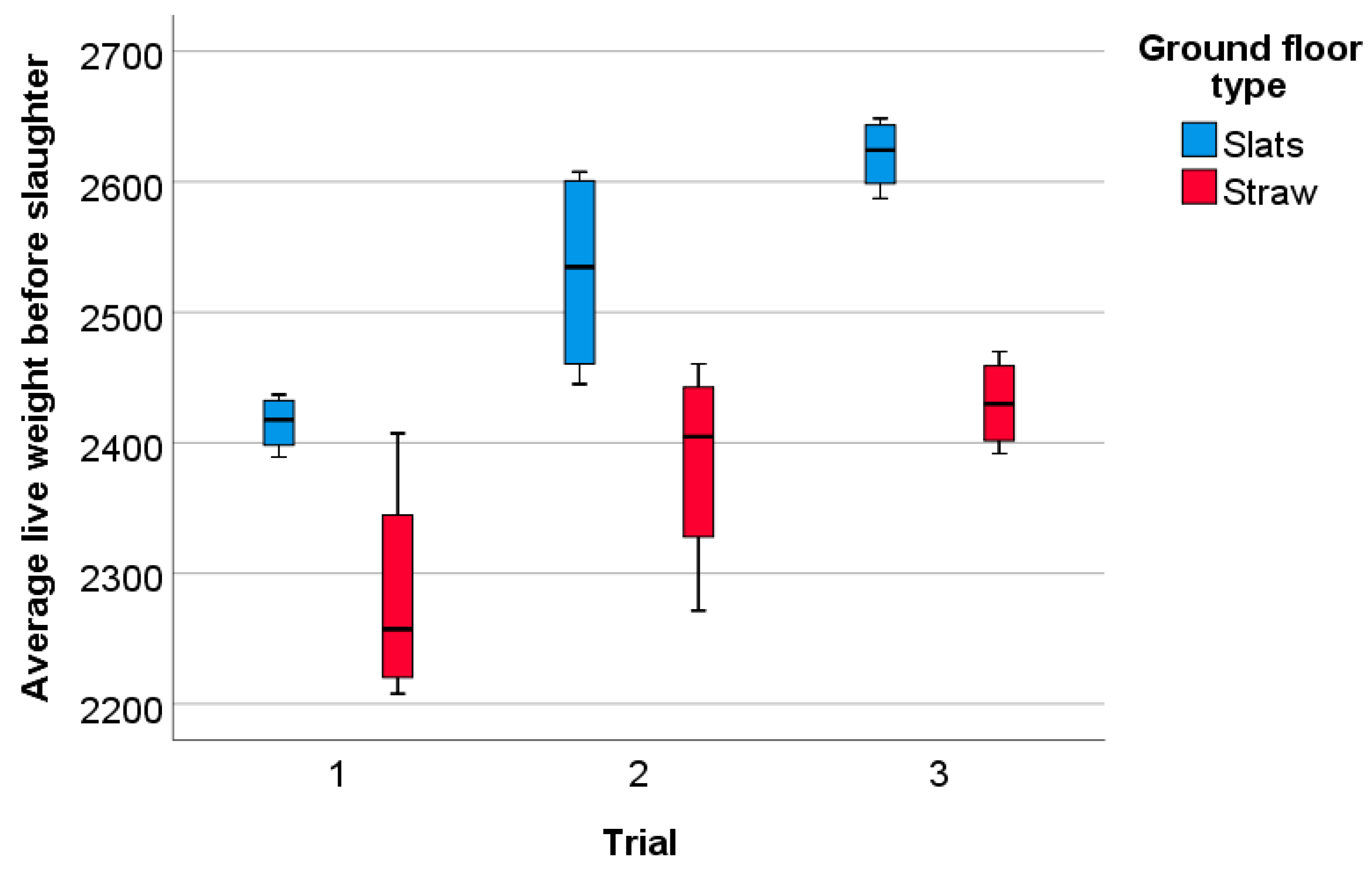
| Score | Definition |
|---|---|
| Clean | Hind legs clean (dry, slight discoloration possible) and clean perirectal area |
| Light soiling | Hind legs slightly dirty, dry, without accumulations of faeces and/or straw sticking to them and clean perirectal area |
| Moderate soiling | Hind legs moderately dirty, dry, possibly slight accumulation of faeces and/or straw sticking to them that can be removed without loss of hair and clean perirectal area |
| Heavy soiling | (a) Hind legs extensively dirty (large areas are dirty due to accumulations of dried faeces and/or straw sticking to legs, not removable without loss of hair) (b) hind legs wet and dirty or (c) perirectal area soiled with soft faeces or diarrhoea |
| Degree of Soiling (%) | Ground Floor Type | ||||||||
|---|---|---|---|---|---|---|---|---|---|
| Slats | Straw | Sig 1 | |||||||
| Med 2 | Min-Max 3 | M 4 | SD 5 | Med | Min-Max | M | SD | ||
| Clean | 15.0 | 0–83.3 | 23.9 | 25.86 | 48.7 | 12.9–96.8 | 48.6 | 32.27 | 0.03 |
| Slightly soiled | 43.3 | 16.7–73.3 | 44.4 | 16.23 | 31.7 | 3.2–46.4 | 29.1 | 15.18 | 0.01 |
| Moderately soiled | 28.6 | 0–63.3 | 29.0 | 15.82 | 13.7 | 0–40.0 | 16.5 | 17.08 | 0.15 |
| Heavily soiled | 3.2 | 0–9.1 | 2.7 | 2.89 | 5.7 | 0–13.3 | 5.9 | 5.83 | 0.25 |
| Causes of Loss Attributed to Body Systems | Ground Floor Type | Total | |
|---|---|---|---|
| Slats | Straw | ||
| Digestive tract 1 | |||
| Number | 17 | 19 | 36 |
| % within system | 56.7% | 55.9% | 56.3% |
| Digestive and respiratory tract | |||
| Number | 12 | 15 | 27 |
| % within system | 40.0% | 44.1% | 42.2% |
| Miscellaneous pathology 2 | |||
| Number | 1 | 0 | 1 |
| % within system | 3.3% | 0% | 1.6% |
| Affected Organs/Pathological Findings | Ground Floor Type | Total | Sig 1 | ||
|---|---|---|---|---|---|
| Slats | Straw | ||||
| Rhinitis | n negative | 26 | 27 | 53 | 0.520 |
| n positive | 4 | 7 | 11 | ||
| Diseases of the lower respiratory tract 2 | n negative | 16 | 15 | 31 | 0.617 |
| n positive | 14 | 19 | 33 | ||
| Otitis | n negative | 28 | 29 | 57 | 0.433 |
| n positive | 2 | 5 | 7 | ||
| Conjunctivitis | n negative | 28 | 32 | 60 | 1.000 |
| n positive | 2 | 2 | 4 | ||
| Diseases of the heart 3 | n negative | 22 | 30 | 52 | 0.199 |
| n positive | 8 | 4 | 12 | ||
| Nephritis | n negative | 28 | 32 | 60 | 1.000 |
| n positive | 2 | 2 | 4 | ||
| Stomach ulcers | n negative | 29 | 31 | 60 | 0.616 |
| n positive | 1 | 3 | 4 | ||
| Enteritis | n negative | 8 | 10 | 18 | 1.000 |
| n positive | 22 | 24 | 46 | ||
| Intestinal coccidiosis | n negative | 7 | 6 | 13 | 0.757 |
| n positive | 23 | 28 | 51 | ||
| Hepatic coccidiosis | n negative | 30 | 33 | 63 | 1.000 |
| n positive | 0 | 1 | 1 | ||
| Necrotising hepatitis | n negative | 29 | 32 | 61 | 1.000 |
| n positive | 1 | 2 | 3 | ||
| Emaciation | n negative | 2 | 1 | 3 | 0.596 |
| n positive | 28 | 33 | 61 | ||
| % Affected within Trial | Chi-Square Test | ||||
|---|---|---|---|---|---|
| Trial 1 | Trial 2 | Trial 3 | χ2 | p | |
| Causes of loss attributed to body systems | |||||
| Digestive tract | 43.75% (↓) | 60.0% | 83.33% (↑) | 5.72 | 0.06 |
| Digestive and respiratory tract | 56.25% ↑ | 40.0% | 8.33% ↓ | 8.27 | 0.02 |
| Miscellaneous pathology | 0% | 0% | 8.33% | 4.40 | 0.11 |
| Affected organs/pathological findings | |||||
| Rhinitis | 28.13% (↑) | 5.0% (↓) | 8.33% | 5.44 | 0.07 |
| Diseases of the lower respiratory tract | 65.63% ↑ | 55.0% | 8.33% ↓ | 11.61 | < 0.01 |
| Otitis | 12.50% | 5.0% | 16.67% | 1.21 | 0.55 |
| Conjunctivitis | 9.38% | 5.0% | 0% | 1.39 | 0.50 |
| Diseases of the heart | 28.13% (↑) | 15.0% | 0% (↓) | 4.80 | 0.09 |
| Nephritis | 9.38% | 0% | 8.33% | 1.96 | 0.38 |
| Stomach ulcers | 0%↓ | 5.0% | 25%↑ | 9.39 | 0.01 |
| Enteritis | 62.50% | 90% (↑) | 66.67% | 4.80 | 0.09 |
| Intestinal coccidiosis | 68.75%↓ | 100% ↑ | 75.00% | 7.63 | 0.02 |
| Hepatic coccidiosis | 3.13% | 0% | 0% | 1.02 | 0.60 |
| Necrotizing hepatitis | 9.38% | 0% | 0% | 3.15 | 0.21 |
| Emaciation | 100% ↑ | 85.0% ↓ | 100% | 6.93 | 0.03 |
© 2019 by the authors. Licensee MDPI, Basel, Switzerland. This article is an open access article distributed under the terms and conditions of the Creative Commons Attribution (CC BY) license (http://creativecommons.org/licenses/by/4.0/).
Share and Cite
Windschnurer, I.; Waiblinger, S.; Hanslik, S.; Klang, A.; Smajlhodzic, F.; Löwenstein, M.; Niebuhr, K. Effects of Ground Floor Type on Selected Health-Parameters and Weight of Rabbits Reared in Group Pens. Animals 2019, 9, 216. https://doi.org/10.3390/ani9050216
Windschnurer I, Waiblinger S, Hanslik S, Klang A, Smajlhodzic F, Löwenstein M, Niebuhr K. Effects of Ground Floor Type on Selected Health-Parameters and Weight of Rabbits Reared in Group Pens. Animals. 2019; 9(5):216. https://doi.org/10.3390/ani9050216
Chicago/Turabian StyleWindschnurer, Ines, Susanne Waiblinger, Stefan Hanslik, Andrea Klang, Fehim Smajlhodzic, Michael Löwenstein, and Knut Niebuhr. 2019. "Effects of Ground Floor Type on Selected Health-Parameters and Weight of Rabbits Reared in Group Pens" Animals 9, no. 5: 216. https://doi.org/10.3390/ani9050216
APA StyleWindschnurer, I., Waiblinger, S., Hanslik, S., Klang, A., Smajlhodzic, F., Löwenstein, M., & Niebuhr, K. (2019). Effects of Ground Floor Type on Selected Health-Parameters and Weight of Rabbits Reared in Group Pens. Animals, 9(5), 216. https://doi.org/10.3390/ani9050216





